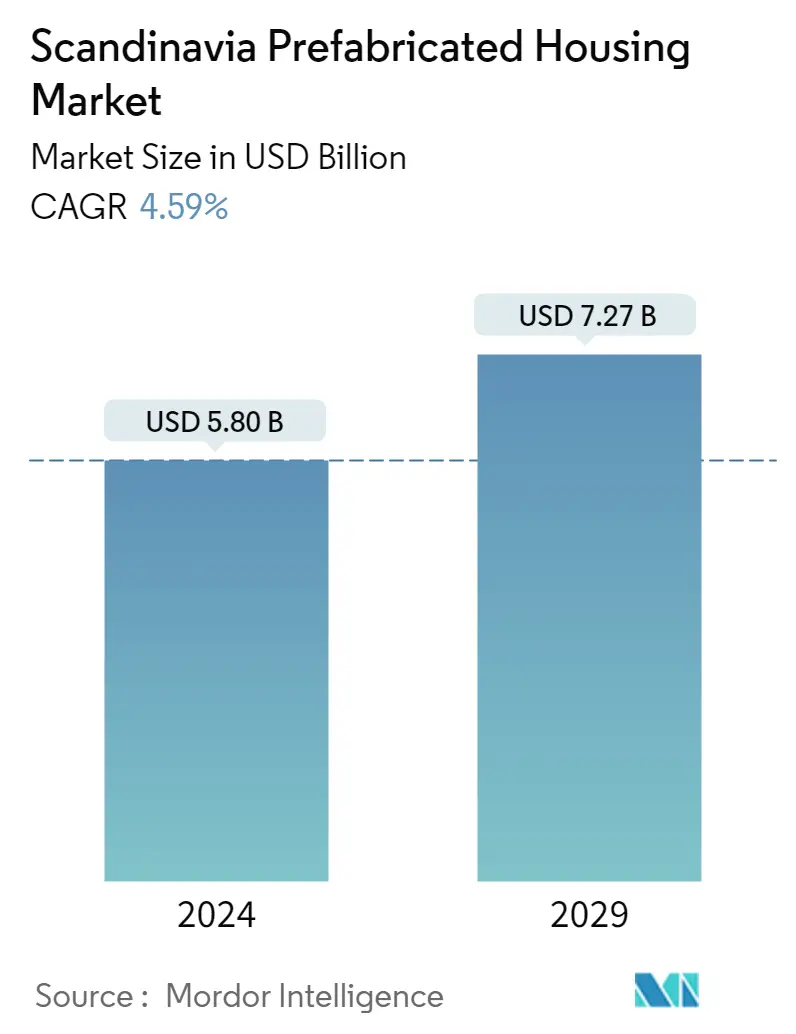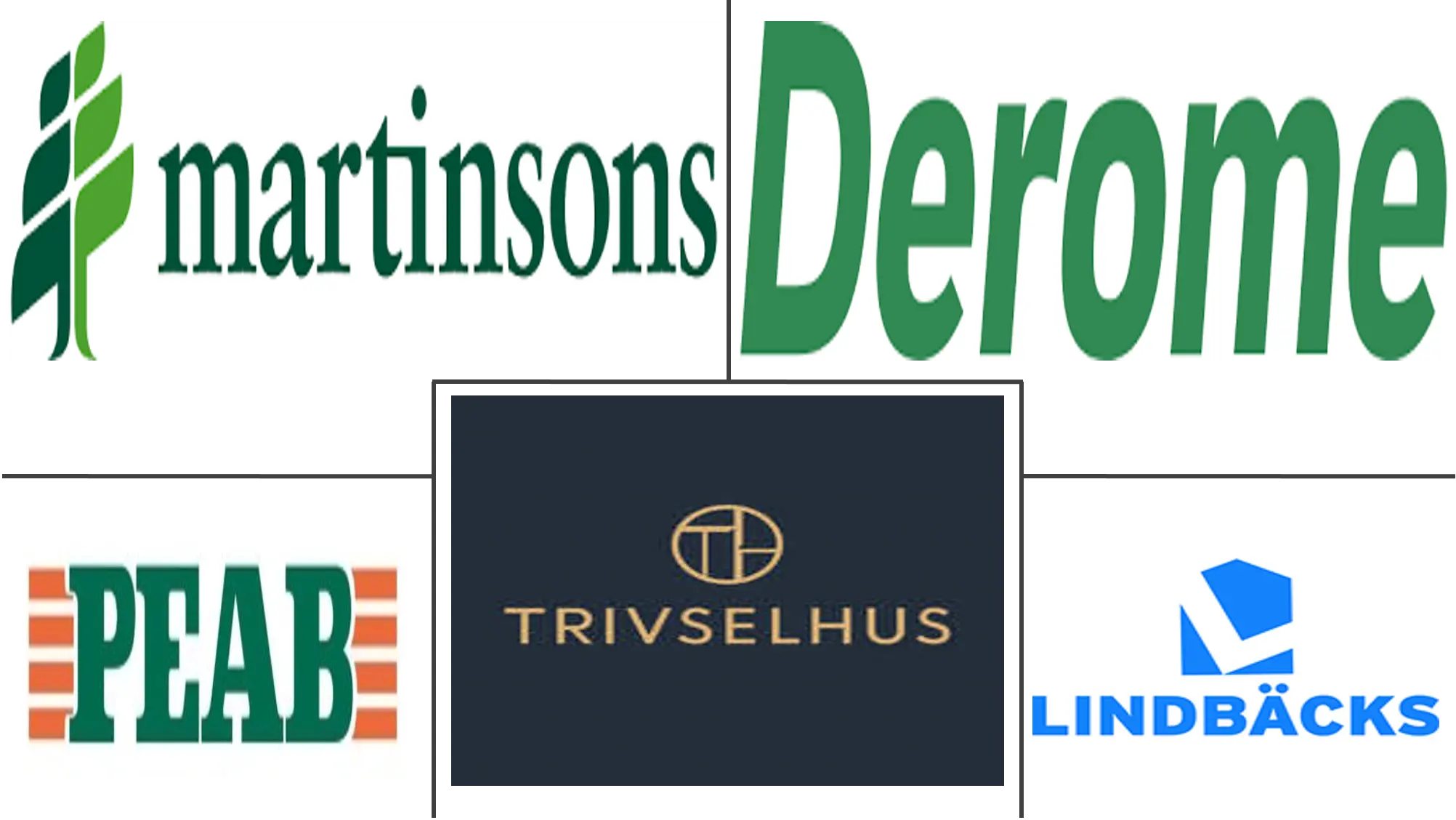Market Size of Scandinavia Prefabricated Housing Industry

| Study Period | 2020 - 2029 |
| Base Year For Estimation | 2023 |
| Market Size (2024) | USD 5.80 Billion |
| Market Size (2029) | USD 7.27 Billion |
| CAGR (2024 - 2029) | 4.59 % |
| Market Concentration | Low |
Major Players
*Disclaimer: Major Players sorted in no particular order |
Scandinavia Prefabricated Housing Market Analysis
The Scandinavia Prefabricated Housing Market size is estimated at USD 5.80 billion in 2024, and is expected to reach USD 7.27 billion by 2029, growing at a CAGR of 4.59% during the forecast period (2024-2029).
The COVID-19 pandemic in 2020 plunged the global economy into recession and led to declines in prefabricated housing construction in Europe, as the lockdown measures and the need to adjust construction practices to accommodate greater social distancing stopped or slowed down projects in the country.
In Scandinavia, several prefabricated building types have flourished in many advanced countries like Norway, Sweden, and Denmark. Modular construction is ideal for construction projects with deadlines, due to which it is increasingly employed in contractual construction projects, which is aiding the market growth. Further, the aim of green building solutions in this region is to boost the demand for modular construction and encourage large construction companies to ramp up investments in cutting-edge building technologies.
The market is driven by the government's plans to upgrade infrastructure. Emerging trends, which directly impact the dynamics of the prefabricated housing industry, include increased usage of cigarette butt bricks in the prefabricated housing industry and increased usage of fly-ash in concrete in prefabricated housing.
Sweden is one of the most developed markets for prefabricated construction in the world, with a high penetration rate. Sweden is widely regarded as a leading country in offsite manufacturing, leading the world in terms of the sheer number of panelized single-dwelling residences, representing over 80 percent of the country's overall housing market. Norway is in Northern Europe, where it borders Sweden, Finland, and Russia. The urban population in Norway is increasing. Today, over 80% of Norway's population lives in the cities, and the number is increasing.
Scandinavia Prefabricated Housing Industry Segmentation
Prefabricated homes, often referred to as prefab homes are primarily manufactured in advance off-site, then delivered and assembled on site. This report covers market insights, such as market dynamics, drivers, restraints, opportunities, technological innovation, and its impact, porter's five forces analysis, and the impact of COVID-19 on the market. In addition, the report also provides company profiles to understand the competitive landscape of the market.
Scandinavia Prefabricated Housing Market is segmented by Type (Single Family and Multi Family), and by Country (Sweden, Norway, and Denmark).
| By Type | |
| Single Family | |
| Multi Family |
| By Country | |
| Sweden | |
| Norway | |
| Denmark |
Scandinavia Prefabricated Housing Market Size Summary
The Scandinavia prefabricated housing market is experiencing a notable expansion, driven by the increasing demand for efficient and sustainable construction solutions. The region, particularly Sweden, Norway, and Denmark, has seen a rise in the adoption of modular construction techniques, which are favored for their ability to meet tight project deadlines and reduce on-site construction time. This trend is further supported by government initiatives aimed at upgrading infrastructure and promoting green building solutions. The market is characterized by a high penetration rate of offsite manufacturing, with Sweden leading globally in the number of panelized single-dwelling residences. The use of innovative materials, such as cigarette butt bricks and fly-ash in concrete, is also gaining traction, contributing to the market's growth.
The urbanization trend in Scandinavia is significantly influencing the demand for prefabricated housing, as more people seek affordable and quickly constructed housing options. Norway, with its rapidly growing urban population, is witnessing increased interest in prefabricated homes due to their cost-effectiveness and reduced construction time compared to traditional methods. The market is highly competitive and fragmented, with key players like Peab AB, Derome AB, and Lindbacks actively investing in housing projects through partnerships and joint ventures. Recent projects, such as those by Lindbäcks, highlight the region's commitment to sustainable construction practices, incorporating features like geothermal heating and solar cells to minimize environmental impact.
Scandinavia Prefabricated Housing Market Size - Table of Contents
-
1. MARKET INSIGHTS
-
1.1 Current Market Scenario
-
1.2 Technological Trends
-
1.3 Insights on Supply Chain/Value Chain Analysis of the Prefabricated Housing Industry
-
1.4 Cost Structure Analysis of the Prefabricated Housing Industry
-
1.5 Impact of COVID-19 on the Market
-
1.6 Insights on Different Types of Materials used in Prefabricated Housing Construction
-
-
2. MARKET SEGMENTATION
-
2.1 By Type
-
2.1.1 Single Family
-
2.1.2 Multi Family
-
-
2.2 By Country
-
2.2.1 Sweden
-
2.2.2 Norway
-
2.2.3 Denmark
-
-
Scandinavia Prefabricated Housing Market Size FAQs
How big is the Scandinavia Prefabricated Housing Market?
The Scandinavia Prefabricated Housing Market size is expected to reach USD 5.80 billion in 2024 and grow at a CAGR of 4.59% to reach USD 7.27 billion by 2029.
What is the current Scandinavia Prefabricated Housing Market size?
In 2024, the Scandinavia Prefabricated Housing Market size is expected to reach USD 5.80 billion.

